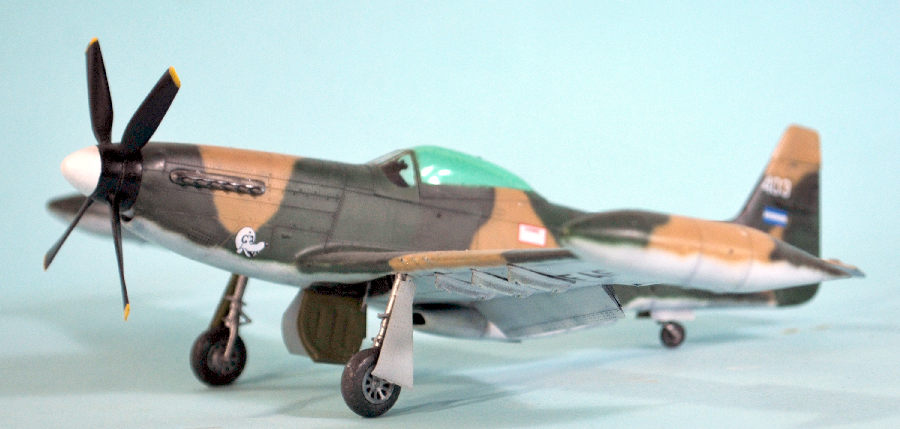
Eduard 1/48 Cavalier Mustang 2
| KIT #: | 84176 |
| PRICE: | $29.95 |
| DECALS: | Four options |
| REVIEWER: | Tom Cleaver |
| NOTES: | Halberd Models Cavalier 2 conversion |

| HISTORY |
The Cavalier Mustang was a post-war civilian version of the P-51 Mustang.Originally intended as a high speed personal aircraft, the Cavalier Mustang was also used as a fighter and close air support aircraft in Third-World air forces.
Newspaper publisher David Lindsay founded Trans-Florida Aviation Inc.in 1957, based in Sarasota, Florida, to turn surplus military P-51s into executive business aircraft. Originally called the Trans- Florida Executive Mustang, they were soon renamed the Trans-Florida Aviation Cavalier Mustang. The first was created in 1958 and over the next few years, a handful of airframes were sold.
The airframes were completely disassembled, military equipment
removed, then rebuilt with a second seat, new avionics, plush leather
interiors, luggage bays, and civilian paint schemes. In 1961, they aircraft
was 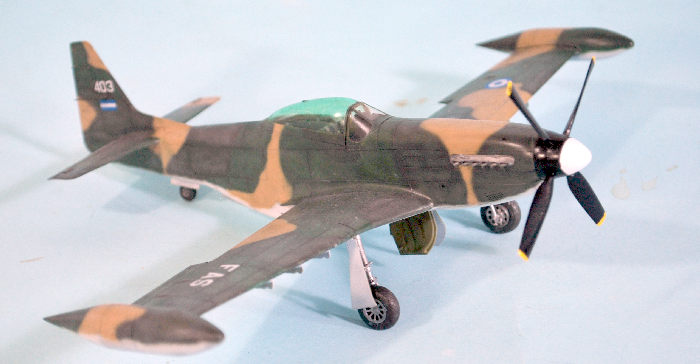 renamed Cavalier 2000, referring to the 2,000-mile range. Five Cavalier
models were eventually offered: the 750, 1200, 1500, 2000, and 2500, with
the name indicating the approximate range. Through the 1960s, 20 aircraft
were built. Several FAA approved modifications were made, including canopy
frame mounted cockpit fresh air vents, 96-gallon wingtip fuel tanks,
fuselage baggage door, 60 gallon gun bay fuel tanks, and a 14-inch taller
vertical fin. In 1967 the company was renamed Cavalier Aircraft Corporation.
renamed Cavalier 2000, referring to the 2,000-mile range. Five Cavalier
models were eventually offered: the 750, 1200, 1500, 2000, and 2500, with
the name indicating the approximate range. Through the 1960s, 20 aircraft
were built. Several FAA approved modifications were made, including canopy
frame mounted cockpit fresh air vents, 96-gallon wingtip fuel tanks,
fuselage baggage door, 60 gallon gun bay fuel tanks, and a 14-inch taller
vertical fin. In 1967 the company was renamed Cavalier Aircraft Corporation.
In 1967, the company was contracted by the Defense Department to create military-specification F-51Ds for export. They incorporated most of the improved features of the civilian Cavaliers but were optimized as ground attack fighters and were called Cavalier F-51D Mustangs; nine single-seat F-51D and two dual-control TF-51Ds were built and given new 67-XXXXX and 68-XXXXX serial numbers. Nine, ncluding the two TF-51s went to Bolivia, under Peace Condor and two, with tip tanks, were sold to the U.S. Army for use as chase aircraft for helicopters; one is preserved at the Air Force Armament Museum at Eglin AFB.
In 1967, Cavalier developed an F-51D designed for CAS and COIN, called Cavalier Mustang II. The aircraft had improved avionics, structural improvements to the wing to allow more external weapons carriage on four additional hardpoints, and an improved Rolls-Royce Merlin V-1650-724A engine.
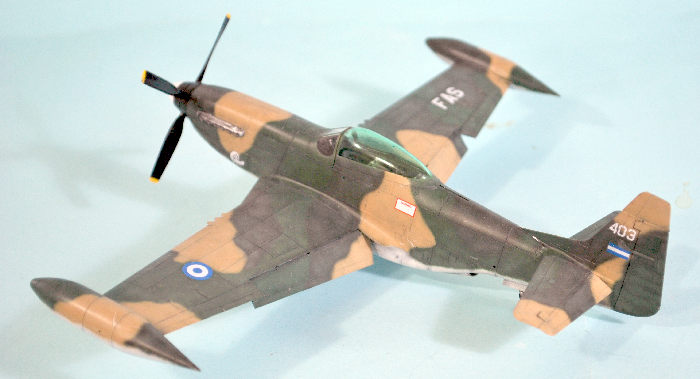 Two batches of Mustang IIs were buiilt: the first was for El
Salvador and delivered in 1968; the second group was for Indonesia in 1972
and 1973. The five El Salvadoraqn Mustang Iis, including one TF-51D,
featured wingtip fuel tanks. The five built for Indonesia did not have tip
tanks due to a U.S. State Department restriction on combat radius.
Two batches of Mustang IIs were buiilt: the first was for El
Salvador and delivered in 1968; the second group was for Indonesia in 1972
and 1973. The five El Salvadoraqn Mustang Iis, including one TF-51D,
featured wingtip fuel tanks. The five built for Indonesia did not have tip
tanks due to a U.S. State Department restriction on combat radius.
The ElSalvadoran Mustang Iis saw limited operational use during the 1969 “Soccer War” between El Salvador and Honduras, with at least one shot down during one of the last piston-engine fighter combats by Honduran F4U-5s.
The Bolivian and El Salvadoran Mustangs were returned to the United States in the mid-1970s, where they were reconditioned as P-51Ds and sold to civilian warbird operators.
| THE KIT |
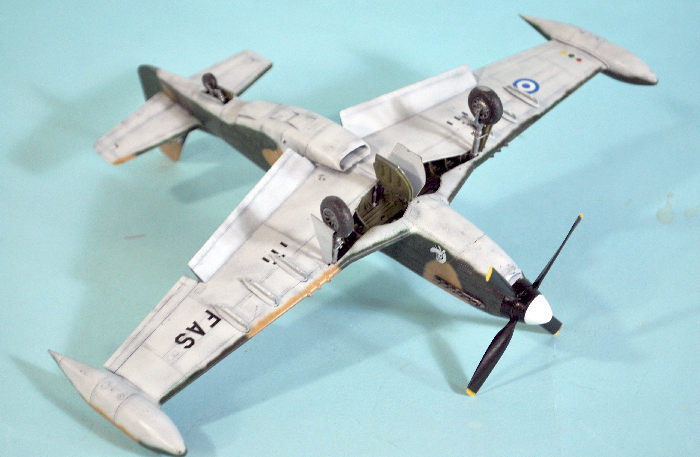 This P-51D-20 “Weekend Kit” is one of
Eduard’s upgrades to their weekend series, with four decal options, including
the famous P-51D painted for Major William Shomo when he was awarded the Medal
of Honor, as well as Wasrren Blodgett’s “Little Chik” from the 78th Fighter
Group, Captain Charles Weaver’s P-51D with the noseart nude, and a P-51D-20 from
the 506th
Fighter Group on Iwo Jima. The kit does not include any photoetch or masks, and
thus sells for $20 less than the Profipack P-51Ds.
This P-51D-20 “Weekend Kit” is one of
Eduard’s upgrades to their weekend series, with four decal options, including
the famous P-51D painted for Major William Shomo when he was awarded the Medal
of Honor, as well as Wasrren Blodgett’s “Little Chik” from the 78th Fighter
Group, Captain Charles Weaver’s P-51D with the noseart nude, and a P-51D-20 from
the 506th
Fighter Group on Iwo Jima. The kit does not include any photoetch or masks, and
thus sells for $20 less than the Profipack P-51Ds.
Halberd Models is a Ukrainian aftermarket company. They have recently produced conversion sets in 1/48 and 1/32 for the Cavalier Mustang II. These feature really excellent resin wingtip tanks, decals for the four countries that flew the type (including the USAF test airplane). The 1/48 set, which sells for $28, is designed for use with the Eduard P-51D. Halberd makes about ten sets a week of this and their Turbo-Mustang III set, in both scales, and puts them up on Saturday morning (US time) at their eBay stores. The sets are soon sold out, not lasting through the weekend. Modelers who want one of these excellent sets are advised to arrive at Halberd’s eBay page early.
| CONSTRUCTION |
The primary difference between assembling this kit and a normal Eduard P-51D is that one leaves out everything in the rear of the cockpit, and replaces that with the extra seat provided in the kit. The resulting interior is not actually accurate for a Cavalier Mustang, which had the upgraded interior. Assuming one can find photos of the cockpit, the changes can be accomplished using Evergreen sheet.
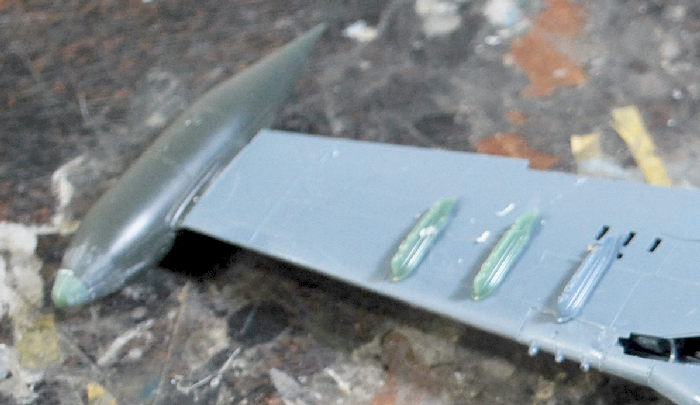 Also, the wingtip outboard of the aileron is cut off along the panel
line, to mount the wingtip tanks. Additionally, one needs to drill out locating
holes for the four additional underwing pylons; the Halberd instructions provide
locating information. The vertical fin and rudder is cut off along the upper
panel line, to attach the resin fin extension. Nothing involved in this work is
hard to do.
Also, the wingtip outboard of the aileron is cut off along the panel
line, to mount the wingtip tanks. Additionally, one needs to drill out locating
holes for the four additional underwing pylons; the Halberd instructions provide
locating information. The vertical fin and rudder is cut off along the upper
panel line, to attach the resin fin extension. Nothing involved in this work is
hard to do.
Since the kit cockpit isn’t actually right for the Cavalier Mustang, and I didn’t have the information to modify it, I decided to “fudge” the issue by tinting the canopy; when the Cavalier Mustang that eventually became Dan Martin’s well-known “Ridge Runner III” warbird arrived at Half Moon Bay from Central America in 1975, it had a tinted canopy, so I copied that.
I tinted the canopy by spraying Tamiya X-25 “Clear Green” thinned 50-50 on the interior surface. The overall effect was not uniform, but when I then dipped the canopy in Future, the Future blended the paint so that it looks uniform. One can see the interior with the canopy closed, without noticing it’s not exactly right.
I attached the underwing pylons, the fin extension and the tip tanks with CA glue. No filling was necessary anywhere. I used late prop blades from an ICM P-51 I had in the spares box.
| COLORS & MARKINGS |
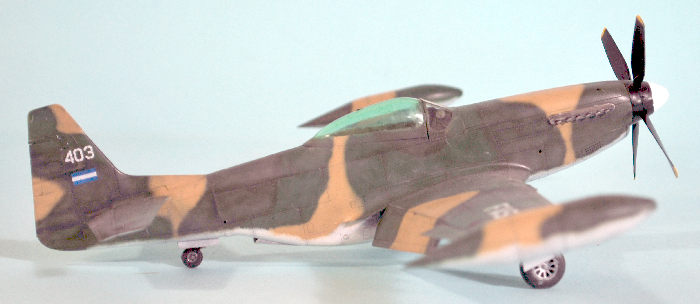 I opted for the Fuerza Aerea Salvadorena Mustang. The upper camouflage
was Tamiya “Desert Yellow,” “Deep Green” and “Black Green,” with the lower
surfaces painted a light grey using Tamoya “Flat White” and a brushful of Flat
Black.
I opted for the Fuerza Aerea Salvadorena Mustang. The upper camouflage
was Tamiya “Desert Yellow,” “Deep Green” and “Black Green,” with the lower
surfaces painted a light grey using Tamoya “Flat White” and a brushful of Flat
Black.
I used the Halberd decals to do an FAS airplane as originally delivered before the Soccer War. The decals went down easily under Micro-Sol.
I assembled the landing gear and attached it, then the prop. I glued the canopy in the closed position.
| CONCLUSIONS |
If you’re a Mustang fanatic, you will want this Mustang II conversion as well as the really good Turbo-Mustang III conversion set, the arrival of which I await. The conversion is easy, no experience in doing conversions necessary, and the result is a very unusual-looking Mustang.
9 December 2021
Copyright ModelingMadness.com. All rights reserved. No reproduction in part or in whole without express written permission.
Kit courtesy of Eduard.
If you would like your product reviewed fairly and fairly quickly, please contact the editor or see other details in the Note to Contributors.